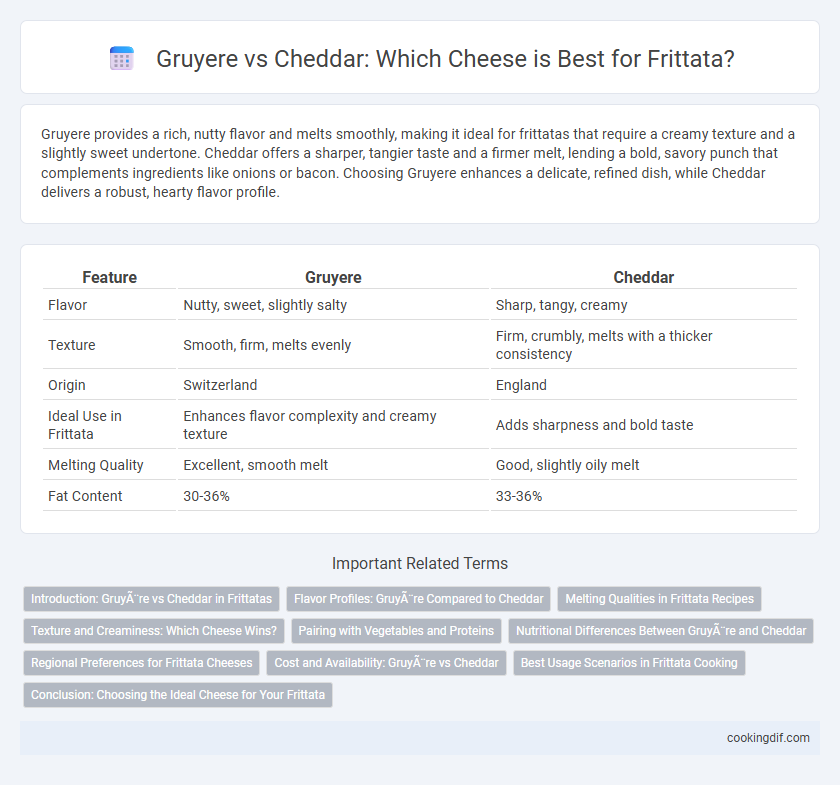Gruyere provides a rich, nutty flavor and melts smoothly, making it ideal for frittatas that require a creamy texture and a slightly sweet undertone. Cheddar offers a sharper, tangier taste and a firmer melt, lending a bold, savory punch that complements ingredients like onions or bacon. Choosing Gruyere enhances a delicate, refined dish, while Cheddar delivers a robust, hearty flavor profile.
Table of Comparison
| Feature | Gruyere | Cheddar |
|---|---|---|
| Flavor | Nutty, sweet, slightly salty | Sharp, tangy, creamy |
| Texture | Smooth, firm, melts evenly | Firm, crumbly, melts with a thicker consistency |
| Origin | Switzerland | England |
| Ideal Use in Frittata | Enhances flavor complexity and creamy texture | Adds sharpness and bold taste |
| Melting Quality | Excellent, smooth melt | Good, slightly oily melt |
| Fat Content | 30-36% | 33-36% |
Introduction: Gruyère vs Cheddar in Frittatas
Gruyere and Cheddar offer distinct flavors and textures when used in frittatas, influencing the dish's overall taste profile. Gruyere provides a creamy, nutty richness that melts smoothly, ideal for a sophisticated and silky frittata. Cheddar contributes a sharper, tangier bite with a firmer melt, perfect for adding boldness and depth to the eggs.
Flavor Profiles: Gruyère Compared to Cheddar
Gruyere offers a rich, nutty flavor with earthy undertones that deepen as the cheese ages, enhancing the frittata's complexity and providing a creamy texture that melts smoothly. Cheddar has a sharper, more tangy taste with a firmer texture that can range from mild to extra sharp, adding a bold flavor contrast in cooked dishes. Using Gruyere in a frittata creates a subtle, sophisticated taste, while Cheddar imparts a more pronounced, robust flavor profile.
Melting Qualities in Frittata Recipes
Gruyere cheese offers superior melting qualities in frittatas, creating a smooth, creamy texture that enhances the dish's richness. Cheddar melts with a sharper, more pronounced flavor but can become greasy or clumpy when cooked at high heat. For optimal frittata recipes, Gruyere provides a balanced melt and a mild nutty taste that blends seamlessly with eggs and vegetables.
Texture and Creaminess: Which Cheese Wins?
Gruyere offers a smooth, creamy texture that melts evenly in a frittata, creating a rich and velvety consistency. Cheddar, especially aged varieties, tends to be firmer and can become slightly crumbly, providing a denser bite but less creaminess. For a frittata prioritizing meltability and a luscious mouthfeel, Gruyere generally outperforms Cheddar in texture and creaminess.
Pairing with Vegetables and Proteins
Gruyere offers a nutty, creamy flavor that pairs exceptionally well with vegetables like spinach, mushrooms, and asparagus, enhancing the overall richness of a frittata. Cheddar provides a sharp, tangy taste that complements proteins such as bacon, sausage, and eggs, adding a bold depth to the dish. Both cheeses melt smoothly, but Gruyere's subtler profile balances delicate vegetables while Cheddar's robustness stands out alongside hearty meats.
Nutritional Differences Between Gruyère and Cheddar
Gruyere cheese contains approximately 413 calories and 33 grams of fat per 100 grams, with higher levels of calcium and vitamin A compared to Cheddar. Cheddar provides around 403 calories and 33 grams of fat per 100 grams, offering slightly more protein and vitamin B12 but less calcium than Gruyere. Both cheeses contain similar sodium levels, making them rich sources of nutrients but differing in specific vitamins and mineral content critical for dietary choices in frittata recipes.
Regional Preferences for Frittata Cheeses
Gruyere cheese, originating from Switzerland, is favored in European frittatas for its nutty flavor and smooth melting texture, enhancing the dish's richness. In contrast, Cheddar, especially sharp varieties from England and the United States, is preferred in North American frittatas for its bold taste and crumbly consistency. Regional preferences for frittata cheeses reflect local dairy traditions, influencing flavor profiles and ingredient authenticity in this versatile Italian egg-based dish.
Cost and Availability: Gruyère vs Cheddar
Gruyere cheese is often more expensive and less readily available than Cheddar due to its specialty status and traditional Swiss production methods. Cheddar is widely produced globally, making it more affordable and accessible in most supermarkets. Cost-efficiency and ease of purchase make Cheddar a practical choice for everyday frittata recipes, while Gruyere offers a unique, rich flavor but at a premium price point.
Best Usage Scenarios in Frittata Cooking
Gruyere offers a creamy texture and nutty flavor that melts evenly, making it ideal for a rich, savory frittata with a smooth consistency. Cheddar, with its sharper taste and firmer texture, works well in frittatas that benefit from a more pronounced cheese flavor and slightly crumbly bite. Gruyere is best for classic, French-inspired recipes, while Cheddar suits rustic or southwest-style frittatas that pair with bold spices and hearty vegetables.
Conclusion: Choosing the Ideal Cheese for Your Frittata
Gruyere offers a creamy texture and nutty flavor that melts smoothly, enhancing the rich ingredients of a frittata without overpowering them. Cheddar provides a sharper, more pronounced taste and firmer texture, delivering boldness to simple egg dishes. Selecting Gruyere suits those seeking a subtle, sophisticated touch, while Cheddar appeals to fans of vibrant, tangy flavors in their frittata.
Gruyère vs Cheddar for cheese Infographic

 cookingdif.com
cookingdif.com